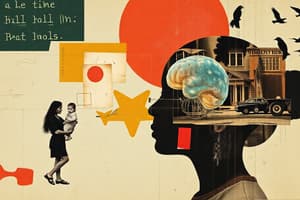Podcast
Questions and Answers
What is the primary focus of Urie Bronfenbrenner's Bio-Ecological Theory?
What is the primary focus of Urie Bronfenbrenner's Bio-Ecological Theory?
- The importance of language in shaping thoughts and behaviors
- The impact of social and cultural context on development
- The influence of immediate and external systems on development (correct)
- The role of genetics in shaping developmental outcomes
According to Lev Vygotsky's Social-Cultural Theory, what is the primary mechanism that drives growth and learning?
According to Lev Vygotsky's Social-Cultural Theory, what is the primary mechanism that drives growth and learning?
- The role of genetics in shaping developmental outcomes
- The influence of language on thought and behavior
- The interplay between immediate and external systems
- The zone of proximal development (correct)
What is the primary purpose of a literature review in research design?
What is the primary purpose of a literature review in research design?
- To identify variables related to the inquiry
- To formulate a hypothesis
- To review past theories and research as a basis for the current study (correct)
- To identify a research question
What is the primary difference between a population and a sample in research design?
What is the primary difference between a population and a sample in research design?
What is the primary role of scaffolding in Lev Vygotsky's Social-Cultural Theory?
What is the primary role of scaffolding in Lev Vygotsky's Social-Cultural Theory?
What is the primary focus of a research question in research design?
What is the primary focus of a research question in research design?
What is the primary purpose of a hypothesis in research design?
What is the primary purpose of a hypothesis in research design?
What is the primary difference between variables in research design?
What is the primary difference between variables in research design?
What is the primary goal of generalizability in research design?
What is the primary goal of generalizability in research design?
What is the primary role of the zone of proximal development in Lev Vygotsky's Social-Cultural Theory?
What is the primary role of the zone of proximal development in Lev Vygotsky's Social-Cultural Theory?
Study Notes
Identity Formation
- Gender identity: a child learns to label themselves as a boy or girl by 2 years old, with awareness starting as early as 9 months.
- Gender stability: a child learns that their gender remains the same throughout life, developing by age 4.
- Gender constancy: a child understands that their gender remains the same even in ambiguous situations, developing by age 4 or 5.
Sexual Identity
- Influenced by societal ideas of gender, including cultural and religious beliefs.
- Aspects include:
- Sexual attraction/orientation.
- Conformity to gender/sexual expectations.
Culture
- A social group that influences an individual's beliefs, behaviors, and ideas.
- Aspects include:
- Race (e.g., Black, White, Asian).
- Ethnicity (e.g., spirituality, nationality).
Social Competence
- Cultural learning from multiple contexts (school, home, community).
- Experience-dependent growth, influencing brain development.
Brain Development
- The brain develops from lower to top, opposite to physical development.
- The triune brain has specialized functions.
- Environmental influence affects brain structures.
Maslow's Hierarchy of Needs
- A foundation of needs must be met for optimal development.
- The pyramid structure represents the hierarchy of needs.
Maturational Theory
- Genetic preset biological timelines.
- Devised by Gesell's Developmental Schedule.
- Identifies delays in typical development.
Areas of Physical Development
- Challenges to growth and development include:
- LBW (Low Birth Weight) or other delays.
- Genetic constraints or disorders.
- Nutrition (poor nutrition or overindulgence).
- Sleep disorders.
- Child/environment interactions.
Peer/Society Relationships
- Societal norms and expectations guide relationship formation.
- Family foundation for social relationships.
- Peer status, including groups, cliques, outcasts, and adult perceptions.
Bio-Ecological Theory
- Development occurs within various systems.
- Systems have indirect and direct influences on developmental outcomes.
Social-Cultural Theory
- Development is impacted by social, historical, and cultural context.
- Intersubjective nature of learning and culturally determined thoughts influence developmental outcomes.
- Zone of Proximal Development (ZPD) drives growth and learning.
Research Design
- Elements include:
- Research question: a measurable inquiry.
- Literature review: examining past theories and research.
- Hypothesis: a supposition or possible explanation.
- Variables: clearly defined factors related to the inquiry.
- Population: the group(s) being investigated.
Studying That Suits You
Use AI to generate personalized quizzes and flashcards to suit your learning preferences.
Description
This quiz covers the formation of identity in children, including friendship formation and gender identity development from preschool to adulthood.




